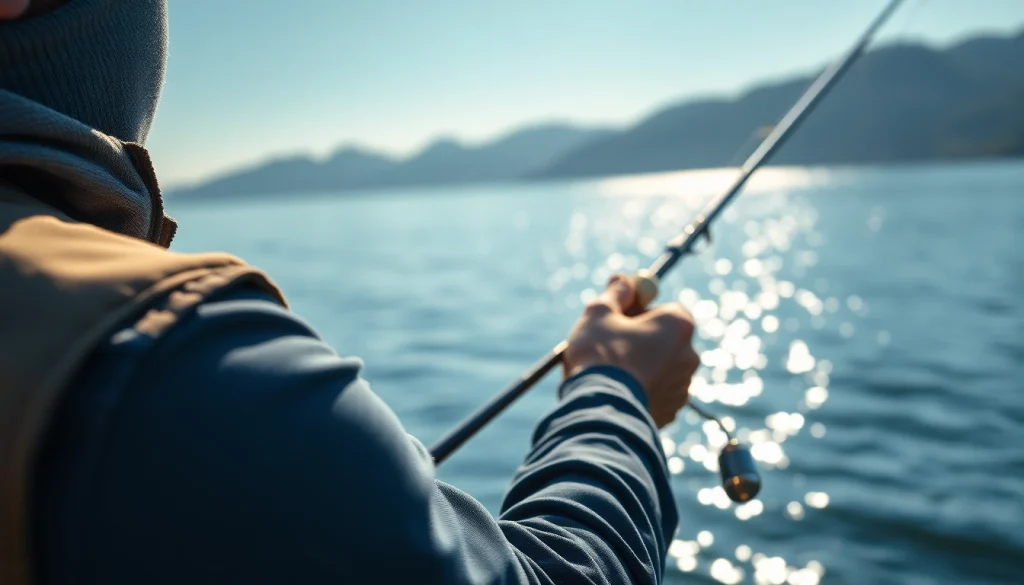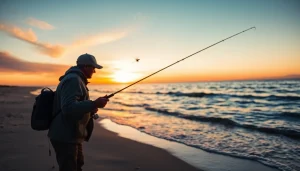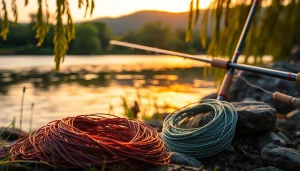Essential Guide to Choosing the Right Fly Fishing Kit for Every Angler

Understanding the Basics of a Fly Fishing Kit
What is a Fly Fishing Kit?
A fly fishing kit is an essential collection of tools and equipment designed to make the art of fly fishing accessible and enjoyable for both novices and seasoned anglers. This kit typically contains various components that facilitate catching fish using artificial flies that mimic natural bait. Unlike conventional fishing, where bait is often used, fly fishing emphasizes technique and understanding fish behavior. The components of a fly fishing kit work together to provide a complete fishing experience, from casting and presentation to fish landing and handling.
Key Components of a Fly Fishing Kit
A complete fly fishing kit generally includes several key components, each playing a vital role in successful angling. These components are:
- Fly Rod: The backbone of your kit, the fly rod varies in length and flexibility based on the type of fishing and the species targeted. A good rod allows for precise casting techniques.
- Fly Reel: This is where the fly line is wound. It offers a mechanism to store and release line while providing drag to control fish during a catch.
- Fly Line: Different weights and types of fly lines are essential to ensure effective casting. The line’s weight helps match the rod and reel, allowing for successful presentation of flies.
- Leader Line: This thin line connects to the fly line and often includes a tippet, aiding in transferring energy during the cast and allowing the fly to sink or float as needed.
- Flies: Artificial flies imitate various insects or baitfish and can include dry flies, nymphs, and streamers. Selecting the right flies is crucial for attracting specific fish types.
- Fly Box: A convenient container for organizing, storing, and protecting flies from damage or moisture.
- Accessories: Various tools such as forceps, nippers, and indicators, enhance the overall fishing experience.
How Fly Fishing Kits Vary by Environment
Fly fishing kits are tailored to different fishing environments, which significantly influences their specific components. For instance:
- Freshwater vs. Saltwater: Kits intended for freshwater may include lighter rods and reels, while saltwater kits are built to withstand corrosive elements and heavier tackle.
- Trout Streams: In fast-moving streams, a kit might feature shorter, more accurate rods paired with smaller, delicate flies that mimic local insect life.
- Lakes and Ponds: Fishing in still waters often requires longer rods and floating lines, allowing for better casts over larger areas.
- Saltwater Flats: Here, sturdier equipment is required to handle larger fish and tough conditions, with weighted flies to reach deeper levels.
Choosing the Right Fly Fishing Kit for Your Needs
Beginner vs. Advanced Fly Fishing Kits
Selecting the appropriate fly fishing kit depends on your experience level. Beginner kits typically include forgiving rods and reels that are easier to learn with, often coupled with instructional material or basic flies. These kits focus on foundational techniques and feature comprehensive support for novices. Advanced kits, however, are more specialized. They may include high-performance rods that require technical casting skills or specific fly types tailored to target particular fish species under various conditions.
Factors to Consider When Selecting a Kit
When selecting a fly fishing kit, consider the following factors:
- Your Skill Level: Beginner kits should prioritize ease of use, while experienced anglers may seek high-quality, advanced equipment for improved performance.
- Target Species: For trout, you may need smaller, lighter gear, while targeting larger species like salmon may require heavier rods and reels.
- Water Type: Consider whether you’ll be fishing in freshwater or saltwater environments, as this can significantly influence your kit selection.
- Budget: Quality fly fishing kits range widely in price. Understand your budget and strive for a good balance between cost and quality.
Where to Buy High-Quality Fly Fishing Kits
High-quality fly fishing kits can be obtained from specialized sporting goods stores, reputable online retailers, or local fly shops. Each venue has its advantages. Local stores often provide the opportunity to receive expert advice, allowing you to handle the gear before purchase. Online retailers often offer wider selections and competitive pricing. Make sure to research and read reviews or consult fellow anglers when deciding where to shop.
Improving Your Skills with the Right Fly Fishing Kit
Techniques to Master with Your Fly Fishing Kit
With a fly fishing kit, mastering various techniques becomes essential for success. Some critical techniques include:
- Cast Techniques: Learning methods like the roll cast, overhead cast, and double haul can significantly enhance casting distance and accuracy.
- Presentation: The way you present your fly is crucial. Techniques like mending the line and adjusting drag can help simulate natural behavior.
- Reading Water: Understanding fish behavior and identifying feeding lanes will increase chances of success. Each water body has unique characteristics.
- Hooking and Landing Fish: Properly setting the hook and managing line tension during the fight is vital for landing fish successfully.
Maintaining Your Fly Fishing Kit for Longevity
Maintenance is crucial to ensure the longevity of your fly fishing kit. Key maintenance practices include:
- Cleaning: After each fishing trip, clean your rod and reel to remove dirt, moisture, and salt particles. Saltwater can corrode metals if not washed off properly.
- Storage: Store your rod and reel in a protective case. Avoid placing heavy objects on your tackle box to prevent damage.
- Regular Inspections: Routinely check your line for nicks and frays. Replace tippets as needed to ensure strong connections to flies.
Common Mistakes to Avoid When Using a Fly Fishing Kit
Even seasoned anglers can make mistakes that impact their fishing experience. Avoid the following:
- Forgetting to Match Gear: Ensure your rod, reel, and line weights are compatible to optimize performance.
- Improper Casting: Practice casting often, as faulty technique hinders your ability to present flies effectively.
- Ignoring Weather Conditions: Fish behavior fluctuates with weather. Adapt your approach based on current conditions for better success.
Expanding Your Fly Fishing Kit Essentials
Upgrading Components of Your Fly Fishing Kit
As you evolve as an angler, consider upgrading components of your fly fishing kit to enhance performance:
- Rods and Reels: Invest in high-quality rods and reels designed for specific conditions, such as lightweight options for casting in tight spaces or heavier models for battling larger species.
- Lines: Experiment with different line types suitable for various fishing techniques, such as floating or sinking lines.
- Flies: Expand your fly selection to include patterns that mimic local bait, seasonal insects, or specific fish species.
Accessories to Enhance Your Fly Fishing Kit
Alongside your basic kit, accessories can significantly improve your experience:
- Fly Box: A high-quality fly box is essential for organizing and protecting your flies.
- Safety Gear: Consider using polarized sunglasses to reduce glare on water surfaces while protecting your eyes.
- Vests and Packs: Keeping your tools handy is vital. Vests and packs designed for fly fishing allow for easy access to everything you need.
How to Customize Your Fly Fishing Kit
Customizing your fly fishing kit allows you to tailor it to your specific preferences and fishing style:
- Personal Fly Selection: Assemble a collection of flies tailored to the species and waters you frequently fish.
- Organizational Systems: Customize your tackle box layout for optimal organization that fits your workflow during outings.
- Tools and Gear: Adapt the accessory tools you carry based on personal preferences and specific fishing techniques that suit your style.
Real-Life Experiences with Fly Fishing Kits
Success Stories from Anglers Using Fly Fishing Kits
Many anglers have rewarding success stories tied to their fly fishing kits. For instance, countless beginners have shared how a well-chosen kit has helped them catch their first fish, igniting a passion for fly fishing that lasts a lifetime. More advanced anglers have talked about how upgrading their kits allowed them to take on new, challenging environments with confidence, resulting in personal records or unexpected catches.
Top Places to Use Your Fly Fishing Kit
Fly fishing can be enjoyed in a variety of breathtaking locations, each providing a unique experience. Consider these popular destinations:
- Mountain Streams: Clear, rushing waters often filled with trout make for a perfect fly fishing adventure.
- Coastal Regions: Saltwater fly fishing is popular for species like tarpon or bonefish in tropical environments.
- Lakes and Ponds: Tranquil settings often provide great opportunities for fishing larger freshwater species.
Feedback on Popular Fly Fishing Kit Brands
While specific brands should not be mentioned, the market offers a myriad of options catering to various skill levels and budgets. Anglers often share insights regarding the durability, performance, and overall value of their chosen kits. Online communities provide a wealth of knowledge, helping newcomers find reputable brands while allowing seasoned anglers to compare newer models or try innovations in tackle technology.







